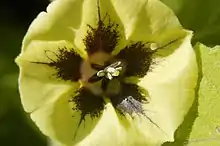Physalis longifolia
Physalis longifolia, known by the common names common groundcherry, longleaf groundcherry,[1] and wild tomatillo,[2] is a species of flowering plant in the nightshade family, Solanaceae. It is native to North America, where it is native to eastern Canada, much of the continental United States,[1] and northern Mexico. It has also been noted as an introduced species in other regions,[3] including parts of the United States outside its native range. In some areas, such as California, it is an occasional noxious weed.[4][5]
| Physalis longifolia | |
|---|---|
 | |
| var. subglabrata | |
| Scientific classification | |
| Kingdom: | Plantae |
| Clade: | Tracheophytes |
| Clade: | Angiosperms |
| Clade: | Eudicots |
| Clade: | Asterids |
| Order: | Solanales |
| Family: | Solanaceae |
| Genus: | Physalis |
| Species: | P. longifolia |
| Binomial name | |
| Physalis longifolia | |
This species is a perennial herb growing 20–60 cm (7.9–23.6 in) tall with somewhat oval-shaped leaf blades 4–7 cm (1.6–2.8 in) long borne on petioles. Flowers occur in the leaf axils. The bell-shaped corolla is up to 2 cm (0.79 in) wide and is yellow with purplish markings around the center. The husk covering the berry is up to 3.5 cm (1.4 in) long with ten veins.[4]
There are two varieties:[3][6]
- P. longifolia var. longifolia
- P. longifolia var. subglabrata (syn. P. subglabrata)
Uses
The yellow-green fruit is edible. The fresh fruit "tastes like an effervescent, under-ripened strawberry", and the dried berry "tastes like a cross between a raisin and dried cranberry."[2] Native American groups used it for food. The Puebloan peoples called the fruits charoka and shuma charoka and ate them fresh or cooked.[2]
The Zuni people referred to the plant and its relative Physalis hederifolia as Ke’tsitokia, and probably used them in similar ways. Women grew it in household gardens. The tomato-flavored berry was boiled and ground with onion, coriander, and chilis to make a dish considered to be a delicacy. The fruit was also dried and mixed into flour for bread. Today the Zuni use the closely related common tomatillo (P. philadelphica) in a sauce recipe derived from the traditional dishes that used wild species.[2]
The var. subglabrata has been listed in government compendia of Louisiana restricted taxa believed to be hallucinogenic, but this is likely inaccurate.[2]
P. longifolia is easy to grow in trials and produces a flavorful fruit.[2]
References
- USDA, NRCS (n.d.). "Physalis longifolia". The PLANTS Database (plants.usda.gov). Greensboro, North Carolina: National Plant Data Team. Retrieved 2 October 2015.
- Kindscher, K.; Long, Q.; Corbett, S.; Bosnak, K.; Loring, H.; Cohen, M.; Timmermann, B. N. (2012). "The Ethnobotany and Ethnopharmacology of Wild Tomatillos, Physalis longifolia Nutt., and Related Physalis Species: A Review" (PDF). Economic Botany. 66 (3): 298–310. doi:10.1007/s12231-012-9210-7. S2CID 2794110.
- "Physalis longifolia". Germplasm Resources Information Network. Agricultural Research Service, United States Department of Agriculture. Retrieved 14 January 2018.
- "Physalis longifolia". The Jepson eFlora. Berkeley: Jepson Herbarium, University of California. 2013.
- "Physalis longifolia". Calflora. 2013.
- Physalis longifolia. ITIS.
